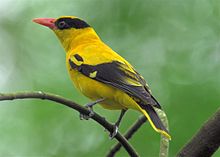| Oriolidae | |
|---|---|

| |
| Black-naped oriole (Oriolus chinensis) | |
| Scientific classification | |
| Domain: | Eukaryota |
| Kingdom: | Animalia |
| Phylum: | Chordata |
| Class: | Aves |
| Order: | Passeriformes |
| Superfamily: | Orioloidea |
| Family: | Oriolidae Vigors, 1825 |
| Type genus | |
| Oriolus Linnaeus, 1766 | |
| Genera | |
|
See text | |
The Old World orioles (Oriolidae) are an Old World family of passerine birds. The family contains 41 species which are divided in 4 genera. The family includes two extinct species from New Zealand that are placed in the genus Turnagra.
Taxonomy and systematics
The family Oriolidae comprises the piopios, figbirds, pitohuis and the Old World orioles. The piopios were added in 2011, having been formerly placed in the family Turnagridae. Several other genera have been proposed to split up the genus Oriolus. For example, the African black-headed species are sometimes placed in a separate genus, Baruffius. The family Oriolidae is not related to the New World orioles, despite their similar size, diet, behaviour and contrasting plumage patterns. Rather, these similarities are an example of convergent evolution.
Extant genera
There are three extant genera in the family Oriolidae:
| Image | Genus | Species |
|---|---|---|
 |
Sphecotheres Vieillot, 1816 – figbirds |
|
 |
Pitohui Lesson, 1831 – pitohuis |
|
 |
Oriolus Linnaeus, 1766 – orioles |
|
Extinct genera
There are at least two extinct genera in the family Oriolidae:
- Genus Turnagra – piopios (2 extinct species)
- Genus Longmornis – Longmornis robustirostrata
Description
The orioles and figbirds are medium-sized passerines, around 20–30 cm in length, with the females only slightly smaller than the males. The beak is slightly curved and hooked, and, except in the figbirds, as long again as the head. The plumage of most species is bright and showy, although the females often have duller plumage than the males do. The plumage of many Australasian orioles mimics that of friarbirds (a genus of large honeyeaters), probably to reduce aggression against the smaller orioles.
Distribution and habitat
The family is distributed across Europe, Africa, Asia, and Australia. The few temperate nesting species are migratory, and some tropical species also show seasonal movements.
Behaviour and ecology
Breeding
Orioles are monogamous, breeding in territorial pairs (although the Australasian figbird, and possibly also the other figbirds, breed in loose colonies). Nesting sites may be chosen near aggressive species such as shrikes, drongos or friarbirds, which confer a degree of protection. The nest is a deep woven cup suspended like a hammock from a branch. They usually lay two or three eggs, but as many as six have been recorded.
Food and feeding
Orioles are arboreal and tend to feed in the canopy. Many species are able to survive in open forests and woodlands, although a few are restricted to closed forest. They are opportunistic omnivores, with the main components of their diet being fruit, berries, arthropods, and nectar.
References
- "Orioles, drongos & fantails « IOC World Bird List". www.worldbirdnames.org. Retrieved 2017-02-18.
- Johansson, Ulf; Eric Pasquet; Martin Irestedt (2011). "The New Zealand Thrush: An Extinct Oriole". PLOS ONE. 6 (9): e24317. Bibcode:2011PLoSO...624317J. doi:10.1371/journal.pone.0024317. PMC 3170299. PMID 21931679.
- Zuccon, D. & Ericson, P. G. (2012). "Molecular and morphological evidences place the extinct New Zealand endemic Turnagra capensis in the Oriolidae". Molecular Phylogenetics and Evolution. 62 (1): 414–26. doi:10.1016/j.ympev.2011.10.013. PMID 22056604.
- ^ Gill, Frank; Donsker, David, eds. (2017). "Orioles, drongos & fantails". World Bird List Version 7.3. International Ornithologists' Union. Retrieved 20 November 2017.
- ^ Walther, B; Jones, P (2008). "Family Oriolidae (Orioles and Figbirds)]". In Josep, del Hoyo; Andrew, Elliott; David, Christie (eds.). Handbook of the Birds of the World. Volume 13, Penduline-tits to Shrikes. Barcelona: Lynx Edicions. pp. 692–713. ISBN 978-84-96553-45-3.
- Diamond J (1982). "Mimicry of friarbirds by orioles" (PDF). The Auk. 99 (2): 187–196.
Further reading
- Jønsson, K.A.; Bowie, R.C.K.; Moyle, R.G.; Irestedt, M.; Christidis, L.; Norman, J.A.; Fjeldså, J. (2010). "Phylogeny and biogeography of Oriolidae (Aves: Passeriformes)". Ecography. 33 (2): 232–241. doi:10.1111/j.1600-0587.2010.06167.x.
- Jønsson, K.A.; Blom, M.P.K.; Marki, P.Z.; Joseph, L.; Sangster, G.; Ericson, P.G.P.; Irestedt, M. (2019). "Complete subspecies-level phylogeny of the Oriolidae (Aves: Passeriformes): Out of Australasia and return". Molecular Phylogenetics and Evolution. 137: 200–209. doi:10.1016/j.ympev.2019.03.015. PMID 30914395.